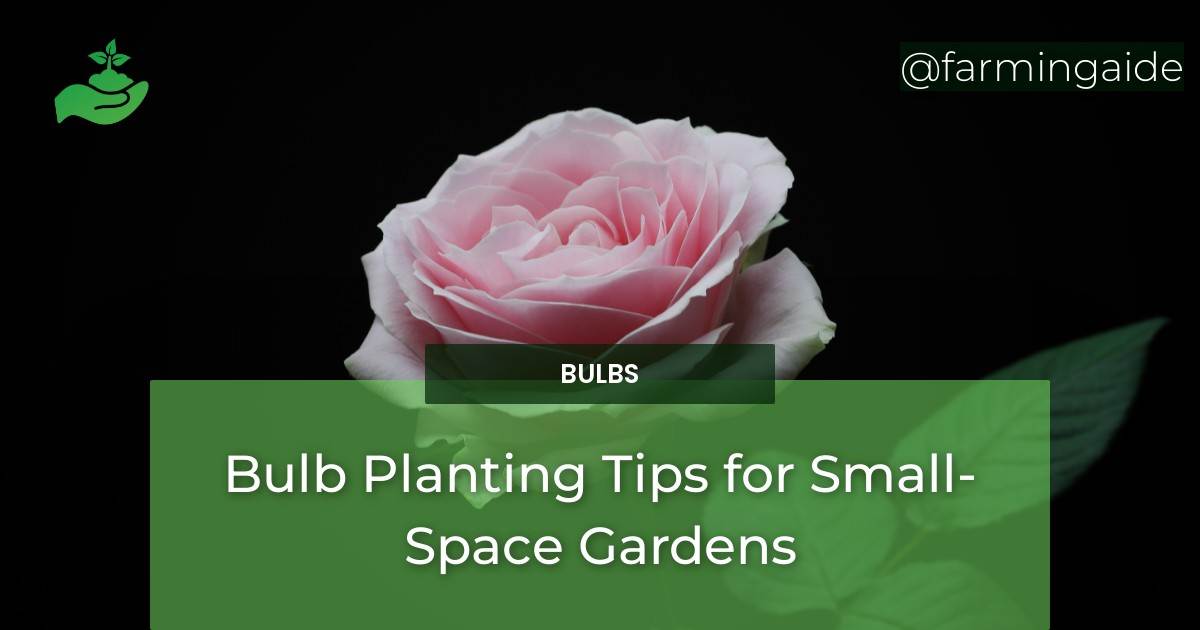Small-space gardens can be charming and inviting, but they can also be a challenge to maintain. If you’re looking for ways to add some color and life to your small garden, bulbs are a great choice. With the right planting techniques, you can enjoy a beautiful and vibrant garden even in limited space. In this article, we will provide you with tips and tricks on how to plant bulbs in small-space gardens, including choosing the right bulbs, container gardening, planting techniques, care and maintenance, and more.
Choosing the Right Bulbs for Small-Space Gardens
When selecting bulbs for your small garden, you want to make sure they fit your space and climate. Here are some things to consider:
Consider the Size of the Bulbs
If you have limited space, it’s best to choose smaller bulbs such as crocuses, snowdrops, and grape hyacinths. Larger bulbs like daffodils and tulips can be overwhelming in small gardens.
Opt for Dwarf Varieties
Dwarf varieties of bulbs are perfect for small gardens because they take up less space but still pack a colorful punch. Some dwarf bulb options include Tulipa tarda, Narcissus ‘Tete-a-Tete,’ and Muscari armeniacum.
Look for Multipurpose Bulbs
Bulbs that can serve more than one purpose, such as edible bulbs, are a great way to save space and add functionality to your garden. Consider planting garlic, onions, or shallots in your small garden.
Container Gardening for Bulbs
If you’re short on garden space, container gardening is an excellent option. Here are some things to keep in mind when planting bulbs in containers:
Select the Right Container
Choose containers that are at least 6-8 inches deep and have good drainage. You can use traditional pots, hanging baskets, or even repurpose old buckets or tins.
Use the Right Soil
Use a high-quality potting mix and consider adding some sand or perlite to improve drainage and aeration. Avoid using garden soil, which can be too dense for containers.
Planting Bulbs in Layers
To get the most out of your container garden, you can plant bulbs in layers. Start by adding a layer of gravel or rocks at the bottom of your container for drainage. Then, add a layer of soil, and plant your bulbs. Cover the bulbs with soil and continue adding bulbs and soil until you reach the top of the container.
ALSO READ
Planting Bulbs in Limited Garden Spaces
Even if you have limited space in your garden, you can still enjoy the beauty of bulbs. Here are some tips for planting bulbs in small gardens:
Group Bulbs Together
Planting bulbs in groups can create a more dramatic effect in a small space. Plant bulbs in clusters of 5-7 for maximum impact.
Use the Space Wisely
Make use of vertical space by planting bulbs in pots or baskets and hanging them on walls or fences. You can also plant bulbs in between existing plants, or in small nooks and crannies.
Mix and Match with Other Plants
Mixing bulbs with other plants can create a beautiful and varied garden. Consider planting bulbs with groundcovers, perennials, or even vegetables.
Care and Maintenance Tips
Once your bulbs are planted, it’s important to take good care of them. Here are some care and maintenance tips for small-space gardens:
Watering Bulbs in Small Gardens
- Water your bulbs deeply once a week, or as needed to keep the soil moist but not waterlogged.
- Be sure to water the soil, not the leaves or flowers, to prevent disease.
Fertilizing Bulbs in Limited Spaces
- Feed your bulbs with a high-phosphorus fertilizer when planting and again when they start to emerge in the spring.
- Avoid over-fertilizing, as this can lead to weak growth and disease.
Preventing Pests and Diseases
- Keep an eye out for pests such as aphids, slugs, and snails, and treat them promptly if you see them.
- Avoid overcrowding your bulbs, as this can lead to disease and fungal growth. Thin out overcrowded bulbs as needed.
Conclusion
Planting bulbs in small-space gardens can be a rewarding and enjoyable experience. By choosing the right bulbs, planting techniques, and taking good care of your bulbs, you can create a beautiful and vibrant garden in any space. Remember to choose bulbs that fit your climate and space, consider container gardening, and mix and match with other plants to create a varied and interesting garden. With these tips, you’ll be on your way to a beautiful and thriving small-space garden in no time!


